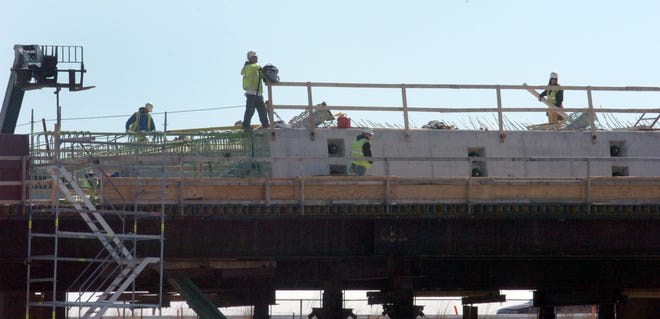Why the Indian River Inlet Bridge lights are blue and 7 other facts you might not know
 Shannon Marvel McNaught
Shannon Marvel McNaughtThe Charles W. Cullen Bridge has been a reliable crossing over the Indian River Inlet for nearly 10 years now.
Building the bridge was no small triumph, with the infrastructure consulting company calling it "an engineering wonder designed for long-term durability, structural integrity, sustainability and aesthetics."
However, prior to the latest version of the bridge opening in 2012, it had a long and troubled history.
Here are some facts you may not know:
1. The bridge took massive amounts of materials to build.
The 2,600-foot-long Charles W. Cullen Bridge cost $150 million to build and consists of 28,000 cubic yards of concrete, 8.85 million pounds of rebar and 1.82 million feet of cables.
That's enough cable to stretch the length of Delaware more than three times.

2. Every person that travels across it saves about an hour's worth of driving time.
The four-lane bridge connects north and south coastal Sussex County, with Dewey Beach to the north and Bethany Beach to the south. Without it, drivers would have to travel to the westernmost reaches of the Indian River, in Millsboro, to cross.
3. The blue lights the bridge is known for aid bats.
Bats have an internal magnetic compass that relies on wavelengths of light, according to a Delaware State Parks Facebook post.
"Unlike other colors, blue light does not disorient them during nighttime hunting," the post said.
4. It is the fifth bridge to span the Indian River Inlet.
There were four previous incarnations of the bridge, all of which the Delaware Department of Transportation said "were eventually undermined by the relentless power of the sea."
- 1934 – Creosote timber bridge
- 1938 – Concrete and steel swing bridge
- 1952 – Concrete and steel swing bridge
- 1965 – Steel girder bridge (widened in 1976)
- 2012 - Cable-stayed bridge
DelDOT required the latest bridge to be built to last at least 100 years.

5. Three men died when the first concrete steel and swing bridge collapsed in 1948.
The Free Lance-Star reported "a section of the Ocean Highway bridge over Indian River Inlet was collapsed by heavy ice" Feb. 10, 1948.
The bridge crumbled under a truck driven by Pasquale Capone of Dover, who ultimately died. Four men tried to help him but were swept into the water, where two of them died as well.
The report said all of the men involved were employees of the Electrical Company of Philadelphia and on a contract job for Delaware Power & Light Co.
Only in Delaware:The backstory on odd place names
6. Construction on today's bridge had to start from scratch after a costly error.
Mounds of dirt that would have supported the approaches to the new bridge began visibly settling and shifting in 2007.
The state sued MACTEC and another company, claiming MACTEC's recommendations on how to build the approaches were flawed. Eventually, the state received a $5.25 million settlement.
At the beach:Ready to get away or just dreaming? 10 most expensive homes for sale at Delaware beaches
In Lewes:"The Pole Family" makes a comeback, after careless driver destroyed them
7. The bridge is equipped with 119 fiber optic sensors.
The sensors were built into the pylons and support cables and underneath the road bed.
They determine how much stress is being exerted on the bridge's structural components as well as measure any wind-related movement and the penetration of road salt into the concrete, according to University of Delaware professor of engineering Harry Shenton.
"Each sensor is associated with a certain wavelength," Shenton said. "When it's strained, the wavelength changes. Based on that data, DelDOT can make changes to the bridge or change traffic patterns."
The Charles W. Cullen Bridge was the first in the country to utilize the technology.
More:Claymont Christmas Weed has a wacky history

8. Nearly 1,200 Delawareans voted on the look of the new bridge.
They chose blue for the color of the cables, a slanted top with a railing for the pylon design and nautical-style light fixtures for the pedestrian walkway.